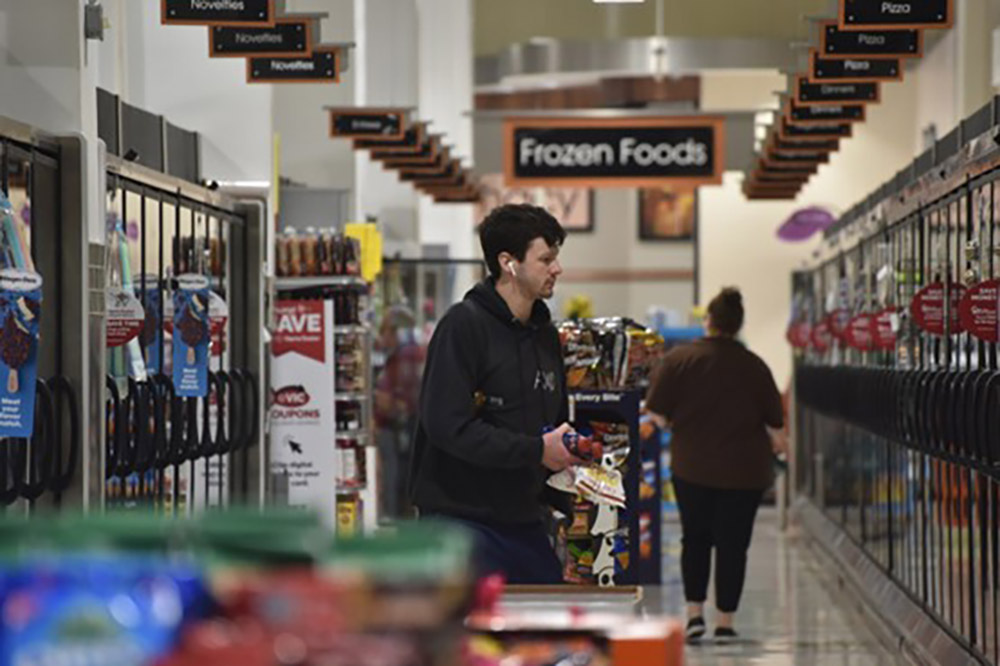
• 面对经济不确定性带来的压力,消费者愈发倾向于借助融资手段购买食品杂货等生活必需品。Lending Tree 4月开展的一项调查表明,今年美国使用该服务采购食品杂货的人群占比攀升至25%,而2024年这一比例为14%。
越来越多美国民众借助各类融资手段购买生活必需品,这是人们对经济状况担忧加剧的最新迹象。据贷款市场平台Lending Tree披露的数据,消费者使用“先买后付”(BNPL)服务购买食品杂货的趋势愈发显著,且逾期还款的消费者数量也在不断攀升。
根据Lending Tree 4月初对2000名美国成年人开展的一项调查,四分之一的购物者曾使用“先买后付”服务购买食品杂货,而一年前这一比例为14%。
与此同时,41%的受访者表示在过去一年中曾逾期还款,不过绝大多数人在一周或更短时间内便完成欠款清偿。男性、年轻群体以及高收入借款人出现逾期还款的概率更高。
“先买后付”服务的热度不断攀升,这与关税及利率不确定性引发的对经济衰退的担忧加剧相吻合。消费者信心持续走低,上周消费者信心指数从一个月前的57降至52.2。美联社-芝加哥大学全国民意研究中心公共事务研究中心(Associated Press–NORC Center for Public Affairs Research)的一项民意调查显示,约有一半的美国人“极其”或“非常”担心未来数月内会出现经济衰退。
Lending Tree首席消费者金融分析师马特·舒尔茨(Matt Schulz)对《财富》杂志表示:“显而易见,当人们在通货膨胀及各类经济不确定性的重压下举步维艰时,他们正寻求诸如‘先买后付’贷款之类的方式来拓宽预算空间。”
“先买后付”作为一种能让用户分期结清购物款项的服务,对于那些希望规避信用卡风险或不愿承担贷款利息的消费者而言,已然成为颇具吸引力的选项。然而,这种便捷的借贷系统也可能诱发过度消费与债务累积,使得提供该服务的信贷公司得以趁机收取隐性滞纳金。
这种支付策略最初在热衷购置奢侈品的高收入群体中风靡,然而其热度持续攀升,可能预示着人们在财务优先事项上的转变。
舒尔茨表示:“‘先买后付’刚兴起时,通常用于购买名牌手袋、电器等商品,如今人们开始将其用于购买食品杂货、订购外卖。”
“先买后付”服务需求日益增长
诸如Afterpay和Klarna这类“先买后付”服务已成功渗透消费市场,赢得消费者认可。上月,DoorDash宣布与Klarna建立合作关系,允许顾客延迟支付或分期支付餐食订单费用。与此同时,贷款服务在大件商品消费领域热度不减。《公告牌》(Billboard)发现,在科切拉音乐节普通门票购买者中,60%选择分期付款,仅需先行支付49.99美元,便能购买原价599美元的门票。
“先买后付”服务风靡,可能表明人们对财务风险的接受程度在不断提高,这一趋势在年轻消费群体中尤为明显。
Z世代经济评论员凯拉·斯坎伦(Kyla Scanlon)上月在社交媒体上表示:“当下的经济充斥着博彩色彩,迷因币炒作、体育投注屡见不鲜。在美国,人们热衷于这类刺激的‘危险游戏’,且参与过程毫无门槛,仿佛连着装束缚都可抛诸脑后,便能轻松入局。”
与此同时,在经济动荡时期,消费者通常会尽量规避风险,然而“先买后付”服务的蓬勃兴起却表明消费者将其视为低风险选项。尽管这项服务无法助力购物者积累信用——而信用本可在未来对财务状况有所帮助。舒尔茨预测,在当前的经济背景下,预计此类贷款仍将热度不减。
他表示:“在我看来,没有任何缘由能让人相信这股热潮会偃旗息鼓,其受欢迎程度只会与日俱增。”(财富中文网)
译者:中慧言-王芳
• 面对经济不确定性带来的压力,消费者愈发倾向于借助融资手段购买食品杂货等生活必需品。Lending Tree 4月开展的一项调查表明,今年美国使用该服务采购食品杂货的人群占比攀升至25%,而2024年这一比例为14%。
越来越多美国民众借助各类融资手段购买生活必需品,这是人们对经济状况担忧加剧的最新迹象。据贷款市场平台Lending Tree披露的数据,消费者使用“先买后付”(BNPL)服务购买食品杂货的趋势愈发显著,且逾期还款的消费者数量也在不断攀升。
根据Lending Tree 4月初对2000名美国成年人开展的一项调查,四分之一的购物者曾使用“先买后付”服务购买食品杂货,而一年前这一比例为14%。
与此同时,41%的受访者表示在过去一年中曾逾期还款,不过绝大多数人在一周或更短时间内便完成欠款清偿。男性、年轻群体以及高收入借款人出现逾期还款的概率更高。
“先买后付”服务的热度不断攀升,这与关税及利率不确定性引发的对经济衰退的担忧加剧相吻合。消费者信心持续走低,上周消费者信心指数从一个月前的57降至52.2。美联社-芝加哥大学全国民意研究中心公共事务研究中心(Associated Press–NORC Center for Public Affairs Research)的一项民意调查显示,约有一半的美国人“极其”或“非常”担心未来数月内会出现经济衰退。
Lending Tree首席消费者金融分析师马特·舒尔茨(Matt Schulz)对《财富》杂志表示:“显而易见,当人们在通货膨胀及各类经济不确定性的重压下举步维艰时,他们正寻求诸如‘先买后付’贷款之类的方式来拓宽预算空间。”
“先买后付”作为一种能让用户分期结清购物款项的服务,对于那些希望规避信用卡风险或不愿承担贷款利息的消费者而言,已然成为颇具吸引力的选项。然而,这种便捷的借贷系统也可能诱发过度消费与债务累积,使得提供该服务的信贷公司得以趁机收取隐性滞纳金。
这种支付策略最初在热衷购置奢侈品的高收入群体中风靡,然而其热度持续攀升,可能预示着人们在财务优先事项上的转变。
舒尔茨表示:“‘先买后付’刚兴起时,通常用于购买名牌手袋、电器等商品,如今人们开始将其用于购买食品杂货、订购外卖。”
“先买后付”服务需求日益增长
诸如Afterpay和Klarna这类“先买后付”服务已成功渗透消费市场,赢得消费者认可。上月,DoorDash宣布与Klarna建立合作关系,允许顾客延迟支付或分期支付餐食订单费用。与此同时,贷款服务在大件商品消费领域热度不减。《公告牌》(Billboard)发现,在科切拉音乐节普通门票购买者中,60%选择分期付款,仅需先行支付49.99美元,便能购买原价599美元的门票。
“先买后付”服务风靡,可能表明人们对财务风险的接受程度在不断提高,这一趋势在年轻消费群体中尤为明显。
Z世代经济评论员凯拉·斯坎伦(Kyla Scanlon)上月在社交媒体上表示:“当下的经济充斥着博彩色彩,迷因币炒作、体育投注屡见不鲜。在美国,人们热衷于这类刺激的‘危险游戏’,且参与过程毫无门槛,仿佛连着装束缚都可抛诸脑后,便能轻松入局。”
与此同时,在经济动荡时期,消费者通常会尽量规避风险,然而“先买后付”服务的蓬勃兴起却表明消费者将其视为低风险选项。尽管这项服务无法助力购物者积累信用——而信用本可在未来对财务状况有所帮助。舒尔茨预测,在当前的经济背景下,预计此类贷款仍将热度不减。
他表示:“在我看来,没有任何缘由能让人相信这股热潮会偃旗息鼓,其受欢迎程度只会与日俱增。”(财富中文网)
译者:中慧言-王芳
• Consumers are feeling the squeeze from economic uncertainty and are turning more to financing essential purchases like groceries. An April survey from Lending Tree shows an increase in Americans using buy-now, pay-later services for groceries—25% this year compared to 14% in 2024.
More Americans are taking advantage of financing options for essential purchases, the latest sign of mounting concern over the health of the economy. Consumers have increasingly turned to buy-now, pay-later (BNPL) services for groceries, according to data released by lending marketplace Lending Tree—and more of those shoppers are paying back those loans late.
One-quarter of shoppers have used BNPL for groceries, up from 14% who used the service a year ago, according to a Lending Tree survey of 2,000 American adults conducted in early April.
Meanwhile, 41% of respondents said they’ve paid back their loan late over the past year, though the vast majority have paid back the money in a week or less. Men, young people, and higher-income borrowers were more likely to make late payments.
The increase in popularity of BNPL has coincided with growing fear of a recession as a result of uncertainty around tariffs and interest rates. Consumer sentiment has continued to weaken, with the index falling to 52.2 last week from 57 a month prior. A poll by the Associated Press–NORC Center for Public Affairs Research found about half of Americans are “extremely” or “very” concerned about the possibility of a recession occurring in the next few months.
“It’s pretty clear that as people struggle with inflation and other kinds of economic uncertainty, people are looking to things like BNPL loans to help them extend their budget,” Matt Schulz, Lending Tree chief consumer finance analyst, told Fortune.
BNPL—a service that allows users to pay back a purchase in incremental chunks—has become an appealing option for consumers interested in avoiding the risks associated with a credit card or paying interest on a loan. However, the frictionless money-borrowing system may also lead to overspending and debt-stacking, allowing the credit companies offering the service to jump on hidden late fees.
The payment strategy made inroads among high earners seeking out luxury products, but its growing popularity may signal a shift in people’s financial priorities.
“When buy-now, pay-later started, it was typically about designer handbags and appliances and things like that,” Schulz said. “But now people are looking at it for things like groceries and food delivery.”
Growing appetite for BNPL
BNPL services offered by apps like Afterpay and Klarna have already found new footholds with consumers. DoorDash last month announced a partnership with Klarna to allow customers to delay or split up payments on food orders. All the while, the loan service is still popular for big-ticket purchases. Billboard found 60% of general admission ticket holders for music festival Coachella used a payment plan for the event. Festivalgoers could pay as little as $49.99 upfront for the event’s $599 price tag.
The ubiquity of BNPL may indicate a growing comfort with financial risks, especially among younger spenders.
“We have a gambling economy,” Gen Z economic commentator Kyla Scanlon said on social media last month. “We have memecoin, sports betting. We love a good vice in the United States, and we can do it completely frictionless. Like, we don’t even have to put on pants.”
At the same time, consumers generally try to avoid risk in times of economic uncertainty, and the rise of BNPL opportunities signals that consumers interpret the service as less risky, despite it not helping shoppers build credit that could help them down the line financially. With the current economic backdrop, expect these loans to remain popular, Schulz predicted.
“I don’t think there’s any reason to believe that this is going to do anything but increase,” he said.






